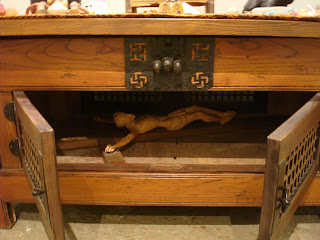My albatross is a crucifix.
When I was twenty-one, chancel queen with one foot out of
the closet that I was, I pored over the catalogue of an ecclesiastical supply
house and told my mother that what I really wanted as a coming-of-age gift was
a 24-inch walnut cross, on which hung a gaunt, mournful, and (it goes without
saying, but I enjoy saying it) nearly naked Jesus carved of German linden wood.
It made feminist friends shudder from the outset. But I was more or less
oblivious to their discomfort over its relentlessly male representation of the
Holy; almost as oblivious as I was to just how blatant my erotic investment must
have been to them, and to nearly everybody else, in that pale, willowy body. Devotion and empathy could channel any amount
of desire and yet remain just barely veiled, at the edge of social
acceptability in a still pervasively homophobic
culture.
(There's no more powerful expression of that than Michel
Marc Bouchard's amazing play, Lilies,
and the superb film made of it by queer Toronto director John Greyson.)
When I bailed out of Christianity altogether for nearly
fifteen years--and it was one of the healthiest decisions I've ever made--Jesus
went into the closet while I came aggressively out of it. When I finally took
another plunge into that rich and deeply flawed tradition, the relation between
the erotic and the spiritual in my life had shifted. The objects of my desire
were alive and breathing around me; I didn't need another in one-quarter scale
nailed to a cross on the wall.
I tried giving the crucifix away, but this Jesus was way too
dead, too white, and/or too male for the taste of anybody to whom I offered it.
So back into the closet went this relic of my past yet again, until I came to
see it in a new light--not as an image that spoke to me in the present, but as
an object that deserved ongoing reverence for its place in my spiritual
history. Finally, my spiritual director came up with the solution: to place it
inside the antique Korean rice chest I use as my altar. It became (like the
relics in a stricter sense contained in the altar of a Roman Catholic church)
the unseen presence supporting the objects that rest upon it in full view.
When a few weeks back I prepared to move house, removing the
crucifix and wrapping it for transport helped me experience the full import of
pulling up stakes and letting go of fifteen years in the house I was leaving.
It helped me stay connected to the personal history I carry with me and inside
me, even as my life changes in ways that sometimes, these days, leave me barely
recognizing myself.
And I can't begin to describe the comfort and exhilaration I
felt yesterday afternoon, setting the altar in its new space, opening the doors
of the chest, and consecrating it anew by laying this ungainly fragment of my
past in the sanctifying darkness of its interior. One by one, the objects laid
above it became again a map of my hopes, of my longings and aspirations; a
pattern for my prayers for those I love, for my memories of those I've lost.



No comments:
Post a Comment